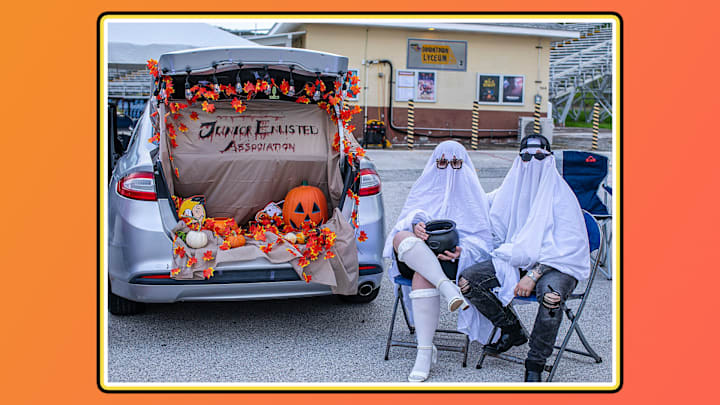Although you might be used to kids walking from doorbell to doorbell every Halloween, in recent years, that tradition has been upstaged by a new one: trunk-or-treat. Rather than knocking on neighborhood doors, kids (and their parents) pile into a designated parking area—perhaps at a church, a local soccer field, or school—and get candy at each car.
It’s essentially kid-friendly Halloween tailgating. Kids wear their costumes, and adults take the opportunity to decorate their car. But just how did the phenomenon of trunk-or-treat become so popular in suburban America?
- A Brief History of Trunk-or-Treat
- Why Trunk-or-Treat Exploded in Popularity
- Halloween Tailgating is Here to Stay
A Brief History of Trunk-or-Treat
Trunk-or-treat is a concept that feels relatively new, and though it has become increasingly popular in the 21st century, it’s actually been around for decades.

Churches were already offering safer (and perhaps less satanic) alternatives to the typical spooky, haunted Halloween activities. The first recorded mentions of trunk-or-treat pop up in the early ’90s, often at church events. A Baptist congregation in Alabama, for example, hosted one in 1994; churches across the South were adding the event to their calendars by the early 2000s.
For some parents, the increased community oversight at these more contained trunk-or-treat festivities was appealing. The organized gatherings were framed as a safer option that involved much less stranger danger. Kids could simply go from car to car in a parking lot full of familiar faces instead of wandering the streets and knocking on unknown doors. (This wariness toward trick-or-treating at unfamiliar houses was in part due to the old “razor blades in apples” panic, even though research has long debunked those urban legends.)

Trunk-or-treat continued to gain traction and spread from churches to malls to schools, and eventually made its way to parking lots throughout suburbia.
You Might Also Like ...
- Why Do We Go Trick-or-Treating on Halloween?
- How Gangsters and the Media Helped Make Trick or Treating a Halloween Tradition
- How Old Is Too Old for Trick or Treating?
Add Mental Floss as a preferred news source!
Why Trunk-or-Treat Exploded in Popularity
There are a few reasons, beyond candy concerns, why parents began embracing trunk-or-treat so quickly:
- Traffic concerns: Car accidents were (and still are) the biggest Halloween hazards. Trunk-or-treating moved kids out of the streets and into controlled spaces.
- Car-centric infrastructure: Most American neighborhoods aren’t exactly walkable these days. If your neighbors live far apart and sidewalk access is slim, door-to-door trick-or-treating becomes more tedious (and dangerous) than fun.
- Inclusion: An in-the-know trunk-or-treat gathering can prepare for things like kids with food allergies and mobility challenges better than non-organized versions of the holiday.
Halloween Tailgating is Here to Stay
Some families still do traditional trick-or-treating later in the evening after stopping by their local trunk-or-treat, but others rely on these Halloween tailgates entirely. Social media has only made the event that much more exciting for parents, turning car decorating into its own mini-competition.

Traditionalists may grumble about the loss of “real” trick-or-treating, but for many families, trunk-or-treat is simply more practical. And hey: candy’s candy, right?
